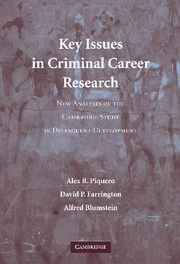 Key Issues in Criminal Career Research
Key Issues in Criminal Career Research Book contents
- Frontmatter
- Contents
- Foreword by Charles F. Wellford
- Acknowledgments
- 1 Introduction
- 2 Overview of Criminal Careers
- 3 Overview of CSDD Data
- 4 How Do Prevalence and Individual Offending Frequency Vary with Age?
- 5 How Does Onset Age Relate to Individual Offending Frequency?
- 6 How Does Specialization/Versatility Vary with Age?
- 7 Comparing the Validity of Prospective, Retrospective, and Official Onset for Different Offending Categories
- 8 What Is the Role of Co-offenders, and How Does It Vary with Age?
- 9 Are Chronic Offenders Serious Offenders, and Does This Relationship Vary with Age?
- 10 Trajectories of Offending
- 11 Developing Estimates of Duration and Residual Career Length
- 12 A Summary and an Agenda for Future Research
- References
- Index
- Titles in the series
8 - What Is the Role of Co-offenders, and How Does It Vary with Age?
Published online by Cambridge University Press: 30 July 2009
- Frontmatter
- Contents
- Foreword by Charles F. Wellford
- Acknowledgments
- 1 Introduction
- 2 Overview of Criminal Careers
- 3 Overview of CSDD Data
- 4 How Do Prevalence and Individual Offending Frequency Vary with Age?
- 5 How Does Onset Age Relate to Individual Offending Frequency?
- 6 How Does Specialization/Versatility Vary with Age?
- 7 Comparing the Validity of Prospective, Retrospective, and Official Onset for Different Offending Categories
- 8 What Is the Role of Co-offenders, and How Does It Vary with Age?
- 9 Are Chronic Offenders Serious Offenders, and Does This Relationship Vary with Age?
- 10 Trajectories of Offending
- 11 Developing Estimates of Duration and Residual Career Length
- 12 A Summary and an Agenda for Future Research
- References
- Index
- Titles in the series
Summary
One of the frequently documented observations about juvenile delinquency is that most offenses are committed with others rather than by persons acting alone (Breckinridge and Abbott, 1917; Reiss and Farrington, 1991) and that this is more characteristic of juveniles than of adults. From the perspective of the criminal career framework, three offending patterns characterize the issue of co-offending: (1) solo offending, where the individual engages in crimes only by himself; (2) a co-offending career, where the individual always offends with others; and (3) a mixed solo and co-offending career, where the individual evinces a mixture of solo and co-offending throughout his/her career, probably beginning with others and then moving into a solo pattern.
Extant criminological theory views the issue of co-offending as important. For example, differential association and social learning theories explicitly rely on the role of co-offending, either through attitudinal or skill transmission or actual offending with others, to explain the onset, persistence, and desistance of criminal activity. Moffitt's developmental taxonomy also implicates the role of co-offenders, but only for one group of offenders: the adolescence-limited. For Moffitt, life-course-persistent offenders do not require the aid and comfort of peers to engage in criminal activity. From her taxonomy, then, it would be expected that co-offending should be most prevalent in mid to late adolescence, just about when offending peaks in the aggregate age/crime curve, only to fall in early to middle adulthood because solo (including life-course-persistent) offenders are more persistent in offending.
- Type
- Chapter
- Information
- Key Issues in Criminal Career ResearchNew Analyses of the Cambridge Study in Delinquent Development, pp. 97 - 122Publisher: Cambridge University PressPrint publication year: 2007
